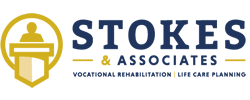articles
Vocational Rehabilitation Considerations In Burn Cases
By: Stokes & Associates
Tel: 504-454-5009
Email Stokes & Associates
View Profile on Experts.com.
Many factors influence the vocational prognosis of individuals who have experienced burn injuries, including residual functional limitations, the environment of the job(s), the need for ongoing scar revision and treatment/therapies, and unique clothing needs/requirements. These should all be considered when determining an individual’s ability to return to work.
The first step in vocational planning is to assess the level and nature of residual impairments. For example, many individuals with burn injuries experience scarring and contractures, which can impact their range of motion, especially in the joints. If burns are to the upper extremities, grasping, handling, and reaching issues can further affect the likelihood of returning to work. Facial burns can also be a deterrent when working in customer-facing roles or in an interview setting with potential employers. Treatment typically involves various types of therapies, which could also affect their ability to maintain employment due to frequently missing work because of appointments.
The physical environment where the individual was working pre-injury should also be considered when determining if a position fits within post-injury limitations. People with burn injuries usually cannot return to work in environments that require outdoor work, exposure to high temperatures, open flames, and chemicals. These restrictions typically rule out many welding jobs, construction jobs, or other occupations requiring outdoor work.
Unique clothing is often needed to protect an individual’s skin following a burn injury. This clothing may or may not be compatible with other clothing requirements outlined by an employer. The vocational counselor can be integral in determining if any accommodations need to be made in the workplace to allow for the clothing necessary to return to work.
A vocational rehabilitation counselor should know the factors that must be addressed when working with individuals who have experienced burn injuries. The counselor should consider the impairment and any restrictions of the individual, the need for ongoing treatment and therapy, environmental aspects of the job, and special clothing requirements needed when determining an individual’s ability to return to work.
Stokes & Associates Experts and Contributors:
Larry S. Stokes, Ph.D., LRC, LPC, CRC, CLCP, CMM
Aaron Wolfson, Ph.D., LRC, CRC, CLCP
Todd Capielano, M.Ed., LRC, LPC, CRC, CLCP, CCM
Ashley Lastrapes, Ph.D., LRC, LPC, CRC, CLCP, CCM
Brandy Bradley, MHS, LRC, CRC, CLCP
Elizabeth Peralta, M.Ed., LRC, CRC, CLCP
Alex Beuerman, MHS, CRC, LRC
Brent Jeansonne, CRC, CLCP, CCM, LRC
Holly McLendon, MHS, CRC, LPC, CLPC, LRC
Lauren Woods-Gaulden, MS, NCC, CRC, LRC, CLCP, PLPC
Shelby Laiche, MHS, CRC, LRC
Heather Dahl, MHS, CRC, PLPC
Stokes & Associates specializes in Life Care Planning and Vocational Rehabilitation. Our team has a combined experience of over 20,000 case assignment engagements. As a result, they can quickly map out a plan to provide the right level of service for the task. Additionally, their detailed Request for Service interview is conducted before work begins to ensure roles and expectations are determined from the onset of their involvement.
©Copyright - All Rights Reserved
DO NOT REPRODUCE WITHOUT WRITTEN PERMISSION BY AUTHOR.
Related articles
Follow us








